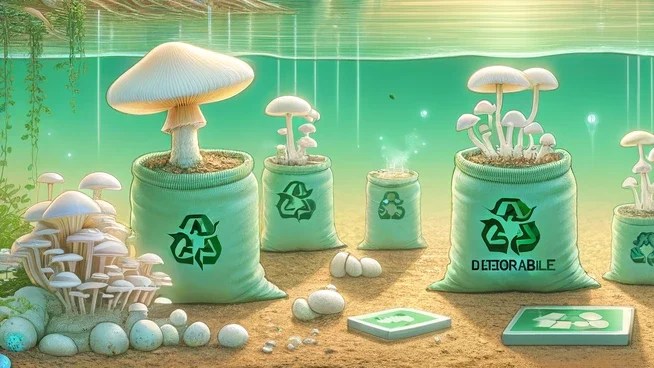
In the mystical realm of mushroom cultivation, the quest for sustainable and eco-friendly practices has become an integral part of the journey for cultivators worldwide. As the demand for magic mushrooms grows, so does the need for environmentally conscious methods. In this exploration, we delve into the realm of sustainable practices in growing magic mushrooms, with a particular focus on the innovative use of grow bags. From biodegradable materials to recycling initiatives, the magic of cultivation meets the wisdom of environmental stewardship.
1. The Rise of Eco-Friendly Grow Bags: Nurturing Nature from the Start
One of the forefronts in sustainable mushroom cultivation lies in the choice of grow bags. Traditional plastic bags, often used in the past, are being replaced by eco-friendly alternatives made from biodegradable materials. These biodegradable grow bags not only provide a suitable environment for mycelial growth but also leave a minimal environmental footprint.
Benefits of Eco-Friendly Grow Bags:
- Biodegradability: Grow bags made from biodegradable materials break down naturally over time, reducing the environmental impact associated with traditional plastic bags.
- Nutrient Contribution: Some eco-friendly grow bags incorporate organic materials into their composition, enriching the substrate with nutrients as they decompose.
2. Recycling in Mushroom Cultivation: Turning Waste into Growth
Recycling plays a pivotal role in sustainable mushroom cultivation, allowing cultivators to repurpose materials and minimize waste. From substrate ingredients to packaging materials, a conscientious effort to recycle contributes to a circular and eco-friendly cultivation process.
Key Aspects of Recycling in Mushroom Cultivation:
- Substrate Recycling: Reusing spent substrate for composting or as a soil amendment reduces the need for new materials, creating a closed-loop system.
- Recyclable Packaging: Choosing grow bags and packaging materials that are recyclable minimizes the environmental impact and encourages responsible waste management.
3. Sustainable Mushroom Growing Systems: Harmony with Nature
Beyond just the materials used, sustainable mushroom cultivation extends to the overall growing systems and practices. Implementing eco-friendly systems contributes to a more harmonious relationship between cultivation and nature.
Components of Sustainable Growing Systems:

- Energy-Efficient Lighting: Utilizing energy-efficient lighting solutions, such as LED systems, reduces energy consumption and environmental impact.
- Water Conservation: Implementing water-efficient irrigation methods minimizes water usage, contributing to sustainable cultivation practices.
4. DIY Mushroom Cultivation with a Green Twist: Empowering the Home Grower
For home growers seeking sustainable alternatives, the DIY approach aligns with eco-conscious values. From creating compostable substrate mixes to repurposing household materials, the DIY mushroom cultivation movement fosters a sense of empowerment and environmental responsibility.
Green Initiatives in DIY Mushroom Cultivation:
- Compostable Substrates: Experimenting with compostable substrate mixes, including kitchen scraps and organic materials, enhances sustainability in the cultivation process.
- Upcycled Containers: Repurposing household items as containers for growing mushrooms adds a creative and eco-friendly dimension to DIY cultivation.
5. Mushroom Liquid Culture and Spores: A Sustainable Inoculation Approach
The process of inoculating substrates with liquid culture or spores presents an opportunity to incorporate sustainable practices. Choosing environmentally friendly alternatives for spore syringes and liquid culture solutions contributes to a holistic approach to sustainability.
Green Choices in Inoculation Techniques:
- Reusable Syringes: Opting for reusable syringes and sterilizing equipment between uses reduces single-use plastic waste.
- Sustainable Spore Sources: Supporting ethical spore vendors who prioritize sustainable harvesting practices ensures that the cultivation journey begins with eco-friendly foundations.
6. The GROmagic Bag: A Contamination-Resistant, Eco-Conscious Choice
The GROmagic Bag, a leader in the world of grow bags, embodies the fusion of contamination resistance and eco-conscious design. Crafted with sustainability in mind, these bags offer a reliable and environmentally friendly option for cultivators aiming for both a contamination-free and eco-conscious cultivation experience.
Features of the GROmagic Bag:
- Biodegradable Components: The GROmagic Bag incorporates biodegradable materials, ensuring a reduced environmental impact compared to traditional plastic bags.
- Contamination Resistance: With self-healing injection ports and advanced filtration systems, the GROmagic Bag prioritizes contamination resistance, maintaining a sterile environment throughout the cultivation process.
7. Organic Mushroom Substrates: Nourishing the Mycelium Naturally
Choosing organic mushroom substrates contributes to sustainable cultivation by supporting the use of natural, chemical-free materials. These substrates promote the health of the mycelium while avoiding the environmental repercussions associated with synthetic additives.
Benefits of Organic Substrates:
- Chemical-Free Cultivation: Organic substrates eliminate the use of synthetic chemicals, fostering a more natural and environmentally friendly growing environment.
- Enhanced Soil Health: After harvesting, spent organic substrate can be composted, enriching soil health and contributing to a circular and sustainable system.
8. Mushroom Air Filtration Bags: Balancing Sterility and Sustainability
Air filtration bags, a critical component in contamination prevention, can also be designed with sustainability in mind. The balance between sterility and sustainability is exemplified in these bags, which prioritize the prevention of contaminants while minimizing environmental impact.
Sustainable Features in Air Filtration Bags:
- Reusable Components: Some air filtration bags feature reusable components, allowing cultivators to extend the lifespan of the filtration system and reduce waste.
- Recyclable Materials: Choosing air filtration bags made from recyclable materials aligns with sustainability goals, ensuring responsible disposal at the end of their life cycle.
9. Community Initiatives: Cultivating Awareness and Collaboration
Sustainable mushroom cultivation extends beyond individual practices to community initiatives that promote awareness and collaboration. Engaging with local and online communities provides a platform for sharing eco-friendly practices and collectively working towards a more sustainable future.
Community-Centric Sustainability Practices:
- Seed Swaps and Substrate Exchanges: Local communities can organize events for sharing seeds, substrates, and sustainable cultivation practices, fostering a sense of collective responsibility.
- Educational Workshops: Online forums and local workshops provide opportunities for cultivators to share knowledge about sustainable practices and inspire others to adopt eco-friendly approaches.
10. Innovations in Eco-Friendly Packaging: Minimizing Footprints
As sustainability gains momentum in the cultivation of magic mushrooms, there’s a growing emphasis on eco-friendly packaging solutions. From minimalistic designs to compostable materials, packaging innovations are reducing environmental footprints in the journey from cultivation to end-users.
Advancements in Eco-Friendly Packaging:
- Minimalistic Designs: Simplifying packaging designs reduces excess materials and waste, aligning with eco-friendly principles.
- Compostable Packaging: Grow kits and products packaged in compostable materials contribute to reducing landfill waste and promoting sustainable disposal practices.
11. Circular Economy in Mushroom Cultivation: Closing the Loop
The concept of a circular economy is gaining momentum in mushroom cultivation, emphasizing the importance of minimizing waste and maximizing resource efficiency. Growers are embracing practices that facilitate the circular flow of materials, reducing the environmental impact associated with cultivation.
Elements of a Circular Economy in Mushroom Cultivation:
- Substrate Recycling Programs: Initiatives promoting the collection and reuse of spent substrates contribute to a circular economy, minimizing the need for new substrate materials.
- Closed-Loop Systems: Implementing closed-loop systems, where waste products become valuable inputs for subsequent cultivation cycles, exemplifies a commitment to sustainable and circular practices.
12. Regenerative Agriculture Techniques: Enhancing Soil Health
Magic mushrooms, being fungi, have an intimate relationship with the soil they grow in. Adopting regenerative agriculture techniques not only enhances the health of the mycelium but also nurtures the ecosystems surrounding cultivation sites.
Regenerative Practices for Soil Health:
- Cover Cropping: Introducing cover crops between cultivation cycles prevents soil erosion, enhances nutrient retention, and promotes microbial diversity in the soil.
- Companion Planting: Cultivating companion plants alongside magic mushrooms can foster symbiotic relationships, supporting soil health and biodiversity.
13. Energy-Efficient Indoor Cultivation: Illuminating the Path to Sustainability
Indoor cultivation, while offering controlled environments for mushroom growth, often comes with energy consumption challenges. Integrating energy-efficient practices and technologies ensures that the magic happens within a sustainable energy framework.
Energy-Efficient Indoor Cultivation Techniques:
- LED Lighting: Switching to energy-efficient LED lighting systems reduces electricity consumption while providing optimal light conditions for mycelial growth and fruiting.
- Smart Climate Control: Employing smart climate control systems that adjust temperature and humidity based on real-time data minimizes unnecessary energy use.
14. Carbon Footprint Reduction Strategies: A Holistic Approach
As the global community strives to combat climate change, mushroom cultivators are exploring ways to reduce their carbon footprint. From production to packaging, every step in the cultivation process offers opportunities to minimize environmental impact.
Strategies for Reducing Carbon Footprint:
- Local Sourcing: Opting for locally sourced materials and substrates minimizes transportation-related emissions, supporting regional economies and reducing the overall carbon footprint.
- Carbon Offsetting: Some cultivators are actively participating in carbon offset programs, balancing their emissions by investing in initiatives that sequester or reduce carbon elsewhere.

15. Mycoremediation: Mushrooms as Environmental Healers
In addition to their culinary and psychedelic attributes, mushrooms, including magic mushrooms, can play a vital role in mycoremediation—using fungi to remediate polluted environments. This sustainable practice aligns with the ethos of nurturing the earth while cultivating magic mushrooms.
Mycoremediation Applications in Mushroom Cultivation:
- Remediating Contaminated Substrates: Magic mushrooms can be cultivated on substrates containing contaminants, contributing to the breakdown and neutralization of pollutants.
- Community Environmental Projects: Collaboration with environmental organizations for mycoremediation projects empowers cultivators to actively engage in environmental restoration efforts.
16. Educational Outreach for Sustainable Mycology: Cultivating Awareness
A sustainable future for magic mushroom cultivation hinges on the dissemination of knowledge and awareness. Educational outreach programs, both online and in local communities, serve as catalysts for inspiring sustainable practices among cultivators.
Components of Sustainable Mycology Education:
- Workshops and Webinars: Hosting workshops and webinars on sustainable cultivation practices equips cultivators with the knowledge and skills needed for eco-conscious mushroom growing.
- Community Gardens: Establishing community gardens dedicated to sustainable mycology provides hands-on learning experiences and fosters a sense of collective responsibility.
17. Biodiversity Conservation Efforts: Protecting Natural Habitats
Magic mushrooms often have symbiotic relationships with specific ecosystems. Cultivators committed to sustainability consider the broader impact of their practices on biodiversity, advocating for the preservation of natural habitats.
Contributions to Biodiversity Conservation:
- Habitat Restoration Projects: Participating in or supporting habitat restoration initiatives helps conserve ecosystems that are crucial for the natural growth of magic mushrooms.
- Native Species Cultivation: Prioritizing the cultivation of native mushroom species contributes to the preservation of local biodiversity.
A Harmony of Magic and Ecology
In the enchanting world of magic mushroom cultivation, the integration of sustainable practices transcends mere cultivation techniques—it becomes a harmonious dance with nature. From the choice of grow bags to regenerative agriculture, from reducing carbon footprints to mycoremediation, each sustainable practice intertwines with the magic of mycology.
As cultivators continue to embark on this journey, may the mycelium weave a narrative of growth, regeneration, and ecological stewardship. In the delicate balance between nurturing magic mushrooms and safeguarding the earth, may every cultivation endeavor contribute to a sustainable legacy for future generations of mycophiles. Happy and sustainable growing!
